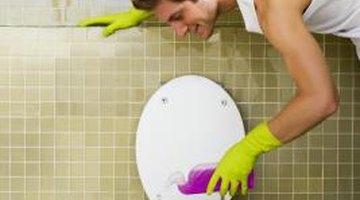Rodding A Toilet
Rodding a toilet is a term that refers to tackling a toilet clog with an auger. The technique is typically the next step after the use of a plunger proved unsuccessful in clearing the clog. Toys, hair, oil, an excess of toilet tissue, items that accidentally fell into the bowl and poor maintenance can all lead to a clogged toilet. While rodding a toilet, wear rubber gloves to prevent contact with potentially harmful bacteria.
About Toilet Augers

Also called a plumber’s snake or closet auger, toilet augers have a long metal tube with a crank on one end and a metal compression-wrapped inner core cable on the other. Augers for household use are about 3 feet long, and the cable resembles a long, flexible drill bit. Some toilet augers have a bend in the metal tube that resembles the letter J. The best augers for rodding a toilet come with a plastic boot that protects the porcelain in your toilet and are kink resistant. You can purchase a toilet auger at most home improvement stores.
How to Rod a Toilet
Place the end of the auger that has the long cable into the toilet’s drain. Hold the long metal tube in your nondominant hand and the crank in the other. Following the manufacturer’s instructions, turn the crank so the cable extends into the toilet. As you crank, the end of the auger will move down the toilet’s pipe and you will feel resistance when the auger catches the clogging culprit in its coils. If you have a minor clog, you can easily retrieve the offending object by rewinding the auger cable from the drain. In instances of tougher clogs, you may need to crank the auger handle in both directions so the coiled cable passes back and forth through the clog. This motion will break up the clog so it can go down the drain.
When Rodding is Not Enough
If a clog in a toilet seems large or you cannot break it down with the auger, you may need to hire a plumber. The toilet clog may result from a problem in the plumbing’s main line, which you can access only by removing the entire toilet stand. Also call a professional if flushing your toilet results in water backing up into sinks or other areas of your home, as this is an indication of a clog in the main line.
Preventing Toilet Clogs
To prevent the need to rod a toilet in the future, clean your toilets weekly, making sure to clean the jets around the edge of the toilet bowl. Teach your children about the proper amount of toilet paper to use and to not use the toilet as a swimming pool for toys. Additionally, avoid using the toilet to dispose of hair, cooking oil, paper towels, baby wipes and anything that will not break down in a septic tank, even if your home does not have a septic tank.
References
Writer Bio
Flora Richards-Gustafson has been writing professionally since 2003. She creates copy for websites, marketing materials and printed publications. Richards-Gustafson specializes in SEO and writing about small-business strategies, health and beauty, interior design, emergency preparedness and education. Richards-Gustafson received a Bachelor of Arts from George Fox University in 2003 and was recognized by Cambridge's "Who's Who" in 2009 as a leading woman entrepreneur.
Photo Credits
- Jupiterimages/Polka Dot/Getty Images
More Articles



